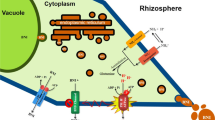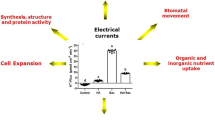Abstract
Background
Sorghum roots release two categories of biological nitrification inhibitors (BNIs) – hydrophilic-BNIs and hydrophobic-BNIs. Earlier research indicated that rhizosphere pH and plasma membrane (PM) H+ATPase are functionally linked with the release of hydrophilic BNIs, but the underlying mechanisms are not fully elucidated. This study is designed to reveal further insights into the regulatory mechanisms of BNIs release in root systems, using three sorghum genetic stocks.
Methods
Sorghum plants were grown in a hydroponic system with pH of nutrient solutions ranging from 3.0 ̴ 9.0. Pharmacological agents [(fusicoccin and vanadate) and anion-channel blockers (−niflumic acid (NIF) and anthracene-9-carboxylate (A9C)] were applied to root exudate collection solutions; BNI activity was determined with luminescent Nitrosomonas europaea bioassay. Sorgoleone levels in root exudates and H+ excretion from roots were determined. Two-phase partitioning system is used to isolate root plasma membrane (PM) and H+ ATPase activity was determined.
Results
A decrease in rhizosphere pH improved the release of hydrophilic-BNIs from roots of all the three sorghum genotypes, but had no effect on the release of hydrophobic-BNIs. Hydrophobic-BNI activity and sorgoleone levels in root-DCM wash are positively correlated. Fusicoccin promoted H+extrusion and stimulated the release of hydrophilic-BNIs. Vanadate, in contrast, suppressed H+ extrusion and lowered the release of hydrophilic-BNIs. Anion-channel blockers did not inhibit the release of hydrophilic BNIs, but enhanced H+-extrusion and hydrophilic-BNIs release.
Conclusion
Rhizosphere pH has a major influence on hydrophilic-BNIs release, but not on the release of hydrophobic-BNIs. The low rhizosphere pH stimulated PM-H+ ATPase activity; H+-extrusion is closely coupled with hydrophilic-BNIs release. Anion-channel blockers stimulated H+ extrusion and hydrophilic-BNIs release. Our results indicate that some unknown membrane transporters are operating the release of protonated BNIs, which may compensate for charge balance when transport of other anions is suppressed using anion-channel blockers. A new hypothesis is proposed for the release of hydrophilic-BNIs from sorghum roots.











Similar content being viewed by others
References
Alsaadawi IS, Al-Uquili JK, Alrubeaa AJ, Al-Hadithy SM (1986) Allelopathic suppression of weed and nitrification by selected cultivars of Sorghum Bicolor (L.) Moench. J Chem Ecol 12:209–219
Amberger A (1989) Research on dicyandiamide as a nitrification inhibitor and future outlook. Commun Soil Sci Plant Anal 20:1933–1955
Baginski ES, Foa PP, Zak B (1967) Determination of phosphate: study of labile organic phosphate interference. Clin Chim Acta 15:155–158
de Boer AH, de Vries-van Leeuwen IJ (2012) Fusicoccanes: diterpenes with surprising biological functions. Trends Plant Sci 17:360–368
Czarnota MA, Rimando AM, Weston LA (2003) Evaluation of seven sorghum (Sorghum sp) accessions. J Chem Ecol 29:2073–2083
Dayan FE, Rimando AM, Pan Z, Baerson SR, Gimsing AL, Duke SO (2010) Sorgoleone. Phytochemistry 71:1032–1039
Hossain AKMZ, Subbarao GV, Pearse SJ, Gopalakrishnan S, Ito O, Ishikawa T, Kawano N, Nakahara K, Yoshihashi T, Ono H, Yoshida M (2008) Detection, isolation and characterization of a root-exuded compound, methyl 3-(4-hydroxyphenyl) propionate, responsible for biological nitrification inhibition by sorghum (Sorghum Bicolor). New Phytol 180:442–451
Iizumi T, Mizumoto M, Nakamura KA (1998) Bioluminescence assay using Nitrosomonas europaea for rapid and sensitive detection of nitrification inhibitors. Appl Environ Microbiol 64:3656–3662
Larsson C (1985) Plasma membrane. In: Modern methods of plant analysis (eds H.F. Linskens & J.F. Jackson). Springer-Verlag, Berlin, pp 85–104
Lewis OAM, James DM, Hewitt EJ (1982) Nitrogen assimilation in barley (Hordeum vulgare L. cv. Mazurka) in response to nitrate and ammonium nutrition. Ann Bot 49:39–49
Marschner H (1995) Mineral nutrition Plant of Higher Plants. Academic, San Diego
Meinshausen M, Meinshausen N, Hare W, Raper SCB, Frieler K, Knutti R, Frame DJ, Allen MR (2009) Greenhouse-gas emission targets for limiting global warming to 2°C. Nature 458:1158–1162
Palmgren MG (2001) Plant plasma membrane H+-ATPases: powerhouses for nutrient uptake. Annu Rev Plant Physiol Plant Mol Biol 52:817–845
Parker JH (1972) How fertilizer moves and reacts in soil. Crops Soils 72:7–11
Raun WR, Johnson GV (1999) Improving nitrogen use efficiency for cereal production. Agron J 91:357–363
Schwartz A, Ilan N, Schwarz M, Scheaffer J, Assmann SM, Schroeder JI (1995) Anion-channel blockers inhibit S-type anion channels and abscisic acid response in guard cells. Plant Physiol 109:651–658
Slangen J, Kerkhoff P (1984) Nitrification inhibitors in agriculture and horticulture: a literature review. Fertil Res 5:1–76
Smart DR, Bloom AJ (2001) Wheat leaves emit nitrous oxide during nitrate assimilation. Proc Nat Acad Sci (USA) 98:7875–7787
Subbarao GV, Ito O, Sahrawat KL, Berry WL, Nakahara K, Ishikawa T, Watanabe T, Suenaga K, Rondon M, Rao IM (2006a) Scope and strategies for regulation of nitrification in agricultural systems – challenges and opportunities. Crit Rev Plant Sci 25:303–335
Subbarao GV, Ishikawa T, Ito O, Nakahara K, Wang HY, Berry WL (2006b) A bioluminescence assay to detect nitrification inhibitors released from plant roots: a case study with Brachiaria humidicola. Plant Soil 288:101–112
Subbarao GV, Rondon M, Ito O, Ishikawa T, Rao IM, Nakahara K, Lascano C, Berry WL (2007a) Biological nitrification inhibition (BNI) – is it a widespread phenomenon? Plant Soil 294:5–18
Subbarao GV, Wang HY, Ito O, Nakahara K, Berry WL (2007b) NH4 + triggers the synthesis and release of biological nitrification inhibition compounds in Brachiara humidicola roots. Plant Soil 290:245–257
Subbarao GV, Ban T, Kishi M, Ito O, Samejima H, Wang HY, Pearse SJ, Gopalakrishnan S, Nakahara K, Hossain AKMZ, Tsujimoto H, Berry WL (2007c) Can biological nitrification inhibition (BNI) genes from perennial Leymus racemosus (Triticeae) combat nitrification in wheat farming? Plant Soil 299:55–64
Subbarao GV, Nakahara K, Hurtado MP, Ono H, Moreta DE, Salcedo AF, Yoshihashi AT, Ishikawa T, Ishitani M, Ohnishi Kameyama M, Yoshida M, Rondon M, Rao IM, Lascano CE, Berry WL, Ito O (2009) Evidence for biological nitrification inhibition in Brachiaria pastures. Proc Nat Acad Sci (PNAS) (USA) 106:17302–17307
Subbarao GV, Sahrawat KL, Nakahara K, Ishikawa T, Kishii M, Rao IM, Hash CT, George TS, Srinivasa Rao P, Nardi P, Bonnett D, Berry W, Suenaga K, Lata JC (2012) Biological nitrification inhibition (BNI) – a novel strategy to regulate nitrification in agricultural systems. Adv Agron 114:249–302
Subbarao GV, Nakahara K, Ishikawa T, Ono H, Yoshida M, Yoshihashi T, Zhu Y, Zakir HAKM, Deshpande SP, Hash CT, Sahrawat KL (2013) Biological nitrification inhibition (BNI) activity in sorghum and its characterization. Plant Soil 366:243–259
Subbarao GV, Yoshihashi T, Worthington M, Nakahara K, Ando Y, Sahrawat KL, Rao IM, Lata JC, Kishii M, Braun H-J (2015) Suppression of soil nitrification by plants. Plant Sci 233:155–164
Subbarao GV, Arango J, Masahiro K, Hooper AM, Yoshihashi T, Ando Y, Nakahara K, Deshpande S, Ortiz-Monasterio I, Ishitani M, Peters M, Chirinda N, Wollenberg L, Lata JC, Gerard B, Tobita S, Rao IM, Braun HJ, Kommerell V, Tohme J, Iwanaga M (2017) Genetic mitigation strategies to tackle agricultural GHG emissions: the case for biological nitrification inhibition technology. Plant Sci 262:165–168
Test M (1990) Tansley review no. 1 plant ion channels: whole-cell and single-channel studies. New Phytol 114:305–340
Tsehaye T, Yoshinaga H, Deshpande SP, Srinivasa Rao P, Sahrawat KL, Ando Y, Nakahara K, Hash CT, Subbarao GV (2014) Biological nitrification inhibition in sorghum: the role of sorgoleone production. Plant Soil 379:325–335
Tyerman SD (1992) Anion channels in plants. Annu Rev Plant Physiol Plant Mol Biol 43:351–357
Weiske A, Benckiser G, Ottow JCG (2001) Effect of the new nitrification inhibitor DMPP in comparison to DCD on nitrous oxide (N2O) emissions and methane (CH4) oxidation during 3 years of repeated applications in field experiments. Nutr Cycl Agroecosys 60:57–64
Yamashita K, Yamamoto Y, Matsumoto K (1996) Characterization of an anion transporter in the plasma membrane of barley roots. Plant Cell Physiol 37(7):949–956
Yan F, Zhu Y, Muller C, Zorb C, Schubert S (2002) Adaptation of H+-pumping and PMH+-ATPase activity in proteoid roots of white lupin under phosphate deficiency. Plant Physiol 129:50–63
Zeng H, Di T, Zhu Y, Subbarao GV (2016) Transcriptional response of plasma membrane H+-ATPase genes to ammonium nutrition and its functional link to the release of biological nitrification inhibitors from sorghum roots. Plant Soil 398:301–312
Zerulla W, Barth T, Dressel J, Erhardt K, Von-Locquenghien KH, Pasda G, Radle M, Wissemeier H (2001) 3, 4- Dimethylpyrazole phosphate (DMPP)-a new nitrification inhibitor for agriculture and horticulture. Biol Fertil Soils 34:79–84
Zhu Y, Yan F, Zörb C, Schubert S (2005) A link between citrate and proton release by Proteoid roots of WhiteLupin (Lupinus albus L.) grown under phosphorus-deficient conditions? Plant Cell Physiol. 46(6):892–901
Zhu YY, Zeng HQ, Shen QR, Ishikawa T, Subbarao GV (2012) Interplay among NH4 + uptake, rhizosphere pH and plasma membrane H+-ATPase determine the release of BNIs in sorghum roots – possible mechanisms and underlying hypothesis. Plant Soil 358:131–141
Acknowledgments
The research presented here is funded by grant-in-Aid for scientific research from Ministry of Agriculture, Forestry and Fisheries of Japan (MAFF) to JIRCAS under BNI project. Funding support also came from Natural Science Foundation of China (NSFC 31172035).
Author information
Authors and Affiliations
Corresponding author
Additional information
Responsible Editor: Ad C. Borstlap.
Rights and permissions
About this article
Cite this article
Di, T., Afzal, M.R., Yoshihashi, T. et al. Further insights into underlying mechanisms for the release of biological nitrification inhibitors from sorghum roots. Plant Soil 423, 99–110 (2018). https://doi.org/10.1007/s11104-017-3505-5
Received:
Accepted:
Published:
Issue Date:
DOI: https://doi.org/10.1007/s11104-017-3505-5




